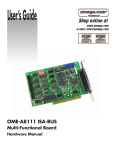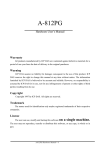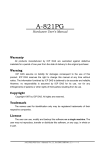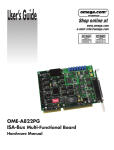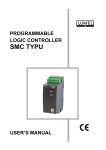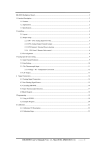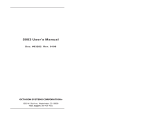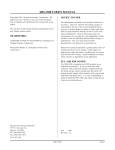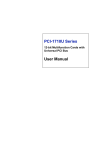Download Manual - ELVAC a.s.
Transcript
A-8111 Hardware User’s Manual Warranty All products manufactured by ICP DAS are warranted against defective materials for a period of one year from the date of delivery to the original purchaser. Warning ICP DAS assume no liability for damage consequent to the use of this product. ICP DAS reserves the right to change this manual at any time without notice. The information furnished by ICP DAS is believed to be accurate and reliable. However, ICP DAS assumes no responsibility for its use, or for any infringements of patents or other rights of third parties resulting from its use. Copyright Copyright 1997 by ICP DAS. All rights are reserved. Trademark The names used for identification only may be registered trademarks of their respective companies. License The user can use, modify and backup this software on a single machine. The user may not reproduce, transfer or distribute this software, or any copy, in whole or in part. A-8111 Hardware Manual (Ver.1.2, Jul/2006, IPH-017-12) ---- 1 Table of Contents 1. Introduction___________________________________________________________ 4 1.1 General 1.2 Features _______________________________________________________________ 4 Description ____________________________________________________ 4 1.3 Specifications ___________________________________________________________ 5 1.3.1 Power Consumption :________________________________________________________ 5 1.3.2 Analog Inputs______________________________________________________________ 5 1.3.3 A/D Converter _____________________________________________________________ 5 1.3.4 DA Converter______________________________________________________________ 6 1.3.5 Digital I/O ________________________________________________________________ 6 1.3.6 Interrupt Channel ___________________________________________________________ 6 1.3.7 Programmable Timer/Counter _________________________________________________ 7 2. 1.4 Applications ____________________________________________________________ 7 1.5 Product Check List ______________________________________________________ 7 Hardware Configuration ________________________________________________ 8 2.1 Board Layout___________________________________________________________ 8 2.2 I/O Base Address Setting _________________________________________________ 9 2.3 Jumper Setting ________________________________________________________ 10 2.3.1 JP1 : D/A Internal Reference Voltage Selection __________________________________ 10 2.4 I/O Register Address____________________________________________________ 11 2.4.1 8254 Counter _____________________________________________________________ 12 2.4.2 2.4.3 2.4.4 2.4.5 2.4.6 2.4.7 2.4.8 2.4.9 2.4.10 A/D Input Buffer Register ___________________________________________________ 12 D/A Output Latch Register __________________________________________________ 13 D/I Input Buffer Register ____________________________________________________ 13 Clear Interrupt Request _____________________________________________________ 14 A/D Gain Control Register __________________________________________________ 14 A/D Multiplex Control Register_______________________________________________ 15 A/D Mode Control Register__________________________________________________ 16 A/D Software Trigger Control Register_________________________________________ 17 D/O Output Latch Register ________________________________________________ 18 2.5 Digital I/O ____________________________________________________________ 19 2.6 8254 Timer/Counter ____________________________________________________ 20 2.7 A/D Conversion ________________________________________________________ 21 2.7.1 A/D conversion flow _______________________________________________________ 22 A-8111 Hardware Manual (Ver.1.2, Jul/2006, IPH-017-12) ---- 2 2.7.2 2.7.3 2.7.4 A/D Conversion Trigger Modes ______________________________________________ 22 A/D Transfer Modes _______________________________________________________ 23 Using software trigger and polling transfer ______________________________________ 23 2.8 D/A Conversion ________________________________________________________ 24 2.9 Analog Input Signal Connection __________________________________________ 25 2.10 Pin Assignment ________________________________________________________ 26 Daughter Board ______________________________________________________________ 28 2.10.1 2.10.2 2.10.3 3. DN-20 for Analog input / output ____________________________________________ 28 DB-16P for Digital input __________________________________________________ 28 DB-16R for Digital output _________________________________________________ 28 Calibration___________________________________________________________ 29 3.1 Calibration VR Description ______________________________________________ 29 3.2 D/A Calibration Steps ___________________________________________________ 30 3.3 A/D Calibration Steps ___________________________________________________ 30 A-8111 Hardware Manual (Ver.1.2, Jul/2006, IPH-017-12) ---- 3 1. Introduction 1.1 General Description The A-8111 is a high performance, multifunction analog, and digital I/O board for the PC AT compatible computer. The A-8111 provides programmable gain. (1, 2, 4, 8, 16) The A-8111 contains a 12-bit ADC with up to 8 single-ended analog inputs. The maximum sample rate of the A/D converter is about 30K sample/sec. There is a 12-bit DAC with voltage outputs, 16 channels of TTL-compatible digital input, and 16 channels of TTL-compatible digital output. 1.2 Features z z z z z z z z The maximum sample rate of the A/D converter is about 30 K sample/sec Software selective input ranges PC AT compatible ISA bus A/D trigger mode: software trigger, pacer trigger 8 single-ended analog input signals Programmable gain: 1, 2, 4, 8, 16 Input range: ±5V, ±2.5V, ±1.25V, ±0.625V, ±0.3125V 1 channel 12-bit D/A voltage output, 0~5V or 0~10V 16 digital input /16 digital output (TTL compatible) Interrupt handling A-8111 Hardware Manual (Ver.1.2, Jul/2006, IPH-017-12) ---- 4 1.3 Specifications 1.3.1 Power Consumption z z z +5V @300mA maximum +12V @60mA maximum -12V @30mA maximum z Operating temperature: 0°C ~ 50°C 1.3.2 z z z z z Channels: 8 single-ended Input range: (software programmable) Bipolar: ±5V, ±2.5V, ±1.25V, ±0.625V, ±0.3125V Input current: 250 nA max (125 nA typical) at 25°C On chip sample and hold Over voltage: continuous single channel to 70Vp-p 1.3.3 z z z z Analog Inputs A/D Converter Type: successive approximation, Burr Brown ADS 774 Conversion time: 8 micro sec. Accuracy: ± 1 bit Resolution: 12 bits A-8111 Hardware Manual (Ver.1.2, Jul/2006, IPH-017-12) ---- 5 1.3.4 z z z z z z DA Converter Channels : 1 independent Type : 12 bit multiplying , Analog device AD-7948 Linearity : ± 1/2 bit Output range : 0~5V or 0~10V jumper selected , may be used with other AC or DC reference input Maximum output limit ± 10V Output drive : ± 5mA settling time : 0.6 microseconds to 0.01% for full scale step 1.3.5 Digital I/O z z Output port : 16 bits, TTL compatible Input port : 16 bits, TTL compatible 1.3.6 z z Interrupt Channel Level : 3,4,5,6,7 jumper selectable Enable : Via control register A-8111 Hardware Manual (Ver.1.2, Jul/2006, IPH-017-12) ---- 6 1.3.7 z z z z z Type : 82C54 -8 programmable timer/counter Counters: The counter1 and counter2 are cascaded as a 32 bits pacer timer. Pacer output : 0.00047Hz to 0.5MHz Input ,gate : TTL compatible Internal Clock : 2M Hz 1.3.8 z z z z z z z z Programmable Timer/Counter Applications Signal analysis FFT & frequency analysis Transient analysis Production test Process control Vibration analysis Energy management Industrial and lab. measurement and control 1.4 Product Check List In addition to this manual, the package includes the following items: z A-8111 multifunction card z A-8111 utility diskette Attention ! If any of these items is missing or damaged, contact the dealer who provided you with this product. Save the shipping materials and carton in case you want to ship or store the product in the future. A-8111 Hardware Manual (Ver.1.2, Jul/2006, IPH-017-12) ---- 7 2. Hardware Configuration 2.1 Board Layout C N3 D/C O UT 1 19 1 19 C N2 D/C IN 8111 2 20 2 20 BASS ADDRESS ON 1 2 3 4 5 6 A ( 9 8 7 6 5 4) SW1 A31 BB A D S-774 P1 JP1 JP2 VR1 VR2 VR3 VR4 VR5 A1 CN1 ---- ANA I/0 A-8111 Hardware Manual (Ver.1.2, Jul/2006, IPH-017-12) 8 2.2 I/O Base Address Setting The A-8111 occupies 16 consecutive locations in I/O address space. The base address is set by DIP switch SW1. The default address is 0x220. A9 A8 A7 A6 A5 A4` 1 2 3 4 5 6 ON SW1 : BASE BASE ADDR ADDRESS A9 A8 A7 A6 A5 A4 200-20F OFF ON ON ON ON ON 210-21F OFF ON ON ON ON OFF 220-22F(;) OFF ON ON ON OFF ON 230-23F OFF ON ON ON OFF OFF : : : : : : : 300-30F OFF OFF ON ON ON ON : : : : : : : 3F0-3FF OFF OFF OFF OFF OFF OFF (;) : default base address is 0x220 A-8111 Hardware Manual (Ver.1.2, Jul/2006, IPH-017-12) ---- 9 The PC I/O port mapping is given below. ADDRESS Device ADDRESS DEVICE 000-1FF PC reserved 320-32F XT Hard Disk 200-20F Game/control 378-37F Parallel Printer 210-21F XT Expansion Unit 380-38F SDLC 238-23F Bus Mouse/Alt. Bus Mouse 3A0-3AF SDLC 278-27F Parallel Printer 3B0-3BF MDA/Parallel Printer 2B0-2DF EGA 3C0-3CF EGA 2E0-2E7 AT GPIB 3D0-3DF CGA 2E8-2EF Serial Port 3E8-3EF Serial Port 2F8-2FF Serial Port 3F0-3F7 Floppy Disk 300-31F Prototype Card 3F8-3FF Serial Port 2.3 Jumper Setting 2.3.1 JP1 : D/A Internal Reference Voltage Selection Reference Voltage -5V (Default) (-10V) JP1 (-5V) JP2 Reference Voltage -10V (-10V) JP1 (-5V) JP2 Select (-5V) : D/A voltage output = 0 to 5V Select (-10V) : D/A voltage output = 0 to 10V A-8111 Hardware Manual (Ver.1.2, Jul/2006, IPH-017-12) ---- 10 2.4 I/O Register Address The A-8111 occupies 16 consecutive PC I/O addresses. The following table lists the registers and their locations. Address Read Write Base+0 8254 Counter 0 8254 Counter 0 Base+1 8254 Counter 1 8254 Counter 1 Base+2 8254 Counter 2 8254 Counter 2 Base+3 Reserved 8254 Counter Control Base+4 A/D Low Byte D/A Channel 0 Low Byte Base+5 A/D High Byte D/A Channel 0 High Byte Base+6 DI Low Byte Reserved Base+7 DI High Byte Reserved Base+8 Reserved A/D Clear Interrupt Request Base+9 Reserved A/D Gain Control Base+A Reserved A/D Multiplexer Control Base+B Reserved A/D Mode Control Base+C Reserved A/D Software Trigger Control Base+D Reserved DO Low Byte Base+E Reserved DO High Byte Base+F Reserved Reserved A-8111 Hardware Manual (Ver.1.2, Jul/2006, IPH-017-12) ---- 11 2.4.1 The 8254 Counter The 8254 Programmable timer/counter has 4 registers from Base+0 through Base+3. For detailed programming information about the 8254, please refer to Intel‘s “Microsystem Components Handbook”. Address Read Write Base+0 8254 Counter 0 8254 Counter 0 Base+1 8254 Counter 1 8254 Counter 1 Base+2 8254 Counter 2 8254 Counter 2 Base+3 Reserved 8254 Counter Control 2.4.2 A/D Input Buffer Register (READ) Base+4 : A/D Low Byte Data Format Bit 7 Bit 6 Bit 5 Bit 4 Bit 3 Bit 2 Bit 1 Bit 0 D7 D6 D5 D4 D3 D2 D1 D0 (READ) Base+5 : A/D High Byte Data Format Bit 7 Bit 6 Bit 5 Bit 4 Bit 3 Bit 2 Bit 1 Bit 0 0 0 0 BUSY D11 D10 D9 D8 A/D 12 bits data : D11…..D0, D11=MSB, D0=LSB BUSY =1 : A/D 12 bits data converting is busy. =0 : A/D 12 bits data is ready The low 8 bits of A/D data are stored in address BASE+4 and the high 4 bits of data are stored in address BASE+5. The BUSY bit is used as an indicator for A/D conversion. When an A/D conversion is completed, the BUSY bit will be cleared to zero (Low). A-8111 Hardware Manual (Ver.1.2, Jul/2006, IPH-017-12) ---- 12 2.4.3 D/A Output Latch Register (WRITE) Base+4 : Channel 1 D/A Low Byte Data Format Bit 7 Bit 6 Bit 5 Bit 4 Bit 3 Bit 2 Bit 1 Bit 0 D7 D6 D5 D4 D3 D2 D1 D0 (WRITE) Base+5 :Channel 1 D/A High Byte Data Format Bit 7 Bit 6 Bit 5 Bit 4 Bit 3 Bit 2 Bit 1 Bit 0 X X X X D11 D10 D9 D8 D/A 12 bits output data : D11..D0, D11=MSB, D0=LSB, X=don‘t care The D/A converter will convert the 12 bits of digital data to analog output. The low 8 bits of D/A channel are stored in address BASE+4 with the high 4 bits are stored in address BASE+5. The D/A output latch registers are designed as a “double buffered” structure, so the analog output latch registers will be updated until the high 4 bits of digital data are written. The users should send the low 8 bits first and then send the high 4 bits to update the 12 bits of AD output latch registers NOTE : Send low 8 bits first, then send high 4 bits. 2.4.4 D/I Input Buffer Register (READ) Base+6 : D/I Input Buffer Low Byte Data Format Bit 7 Bit 6 Bit 5 Bit 4 Bit 3 Bit 2 Bit 1 Bit 0 D7 D6 D5 D4 D3 D2 D1 D0 (READ) Base+7 : D/I Input Buffer High Byte Data Format Bit 7 Bit 6 Bit 5 Bit 4 Bit 3 Bit 2 Bit 1 Bit 0 D15 D14 D13 D12 D11 D10 D9 D8 D/I 16 bits input data : D15..D0, D15=MSB, D0=LSB A-8111 provides 16 TTL compatible digital input. The low 8 bits are stored in address BASE+6. The high 8 bits are stored in address BASE+7. A-8111 Hardware Manual (Ver.1.2, Jul/2006, IPH-017-12) ---- 13 2.4.5 Clear Interrupt Request (WRITE) Base+8 : Clear Interrupt Request Format Bit 7 Bit 6 Bit 5 Bit 4 Bit 3 Bit 2 Bit 1 Bit 0 X X X X X X X X X=don‘t care, XXXXXXXX=any 8 bits data is validate If A-8111 is working in the interrupt transfer mode, an on-board hardware status bit will be set after each A/D conversion. This bit must be cleared by the software before next hardware interrupt. Writing any value to address BASE+8 will clear this hardware bit and the hardware will generate another interrupt when next the A/D conversion is completed. 2.4.6 A/D Gain Control Register (WRITE) Base+9 : A/D Gain Control Register Format Y Bit 6 Bit 5 Bit 4 Bit 3 Bit 2 Bit 1 Bit 0 X X X X X GAIN2 GAIN1 GAIN0 The only difference between the A-8111 and the A-8111 is the GAIN control function. The A-8111 provides a gain factor of 1/2/4/8/16. The gain controls register control the gain of the A/D input signal. Bipolar/Unipolar will affect the gain factor. NOTE : If the gain control code is changed, the hardware needs to have extra gain settling time. The gain settling time is different for different gain control code. The software driver does not monitor the gain settling time, so the user needs to delay the gain settling time if the gain changed. A-8111 GAIN CONTROL CODE TABLE GAIN Input Range GAIN2 GAIN1 GAIN0 Settling Time 1 +/- 5V 0 0 0 2.1 us 2 +/- 2.5V 0 0 1 2.5 us 4 +/- 1.25V 0 1 0 2.7 us 8 +/- 0.625V 0 1 1 3.6 us 16 +/- 0.3125V 1 0 0 4.1 us A-8111 Hardware Manual (Ver.1.2, Jul/2006, IPH-017-12) ---- 14 2.4.7 A/D Multiplex Control Register (WRITE) Base+A : A/D Multilexer Control Register Format Bit 7 Bit 6 Bit 5 Bit 4 Bit 3 Bit 2 Bit 1 Bit 0 X X X X X D2 D1 D0 A/D input channel selection data =3 bits : D2..D0, D2=MSB, D0=LSB, X=don‘t care Channel Bit_2 Bit_1 Bit_0 0 0 0 0 1 0 0 1 2 0 1 0 3 0 1 1 4 1 0 0 5 1 0 1 6 1 1 0 7 1 1 1 NOTE: The settling time of the multiplexer depends on the source resistance of input sources. Source resistance =About 0.1K ohm Î Settling time = About 3 us. Source resistance =About 1K ohm Î Settling time = About 5 us. Source resistance =About 10K ohm Î Settling time = About 10 us. Source resistance =About 100K ohm Î Settling time = About 100 us. Sec 2.4.6 gives information about how to delay the settling time. A-8111 Hardware Manual (Ver.1.2, Jul/2006, IPH-017-12) ---- 15 2.4.8 A/D Mode Control Register (WRITE) Base+B : A/D Mode Control Register Format Bit 7 Bit 6 Bit 5 Bit 4 Bit 3 Bit 2 Bit 1 Bit 0 X SI2 SI1 SI0 X D2 D1 D0 X=don‘t care Mode Select D2 D1 D0 Trigger Type Transfer Type Software Trig Pacer Trig Software Interrupt 0 0 0 Select X Select X 0 0 1 Select X Select X 0 1 0 X Select X X 1 1 0 X Select Select Select X=disable SI2 SI1 SI0 IRQ Level 0 0 0 IRQ2 0 0 1 Not used 0 1 0 IRQ2 0 1 1 IRQ3 1 0 0 IRQ4 1 0 1 IRQ5 1 1 0 IRQ6 1 1 1 IRQ7 The A/D conversion operation can be divided into 2 stages, trigger stage and transfer stage. The trigger stage will generate a trigger signal to the A/D converter and the transfer stage will transfer the results to the CPU. The trigger method may be a software trigger or a pacer trigger. The software trigger is very simple but can not control the sampling rate very precisely. In software trigger mode, the program issues a software trigger command (sec. 2.4.9) any time needed. Then the program will poll the A/D status bit until the BUSY bit is 0 (sec. 2.4.2). A-8111 Hardware Manual (Ver.1.2, Jul/2006, IPH-017-12) ---- 16 The pacer trigger can control the sampling rate very precisely. So the converted data can be used to reconstruct the waveform of the analog input signal. In pacer trigger mode, the pacer timer will periodically generate trigger signals to the A/D converter. This converted data can be transfer to the CPU by polling or interrupt transfer method. The software driver provides two date transfer methods: polling or interrupt. The polling subroutine, A-8111_AD_PollingVar() or A-8111_AD_PollingArray(), sets the A/D mode control register to 0x10. This control word means software trigger and polling transfer. The interrupt subroutine, A-8111_AD_INT_START(…), sets the A/D mode control mode register to 0x06. This control word means pacer trigger and interrupt transfer. 2.4.9 A/D Software Trigger Control Register (WRITE) Base+C : A/D Software Trigger Control Register Format Bit 7 Bit 6 Bit 5 Bit 4 Bit 3 Bit 2 Bit 1 Bit 0 X X X X X X X X X=don‘t care, XXXXXXXX=any 8 bits data is validate The A/D converter can be triggered by software trigger or pacer trigger. Detailed information is given in sec.2.4.8 and 2.7. Writing any value to address BASE+C will generate a trigger pulse to the A/D converter and initiate an A/D conversion operation. The address BASE+5 offers a BUSY bit to indicate that an A/D conversion is complete. The software driver uses this control word to detect the A-8111 hardware board. The software initiates a software trigger and checks the BUSY bit. If the BUSY bit cannot clear to zero in a fixed time, the software driver will return an error message. If there is an error in the I/O BASE address checking procedure, the driver will determent that there is no A-8111 existing with the I//O Base address. A-8111_CheckAddress() is used to detect the A-8111 with the specified I/O BASE is existing or not. A-8111 Hardware Manual (Ver.1.2, Jul/2006, IPH-017-12) ---- 17 2.4.10 D/O Output Latch Register (WRITE) Base+D : D/O Output Latch Low Byte Data Format Bit 7 Bit 6 Bit 5 Bit 4 Bit 3 Bit 2 Bit 1 Bit 0 D7 D6 D5 D4 D3 D2 D1 D0 (WRITE) Base+E : D/O Output Latch High Byte Data Format Bit 7 Bit 6 Bit 5 Bit 4 Bit 3 Bit 2 Bit 1 Bit 0 D15 D14 D13 D12 D11 D10 D9 D8 D/O 16 bits output data : D15..D0, D15=MSB, D0=LSB The A-8111 provides 16 TTL compatible digital outputs. The low 8 bits are stored in address BASE+D. The high 8 bits are stored in address BASE+E A-8111 Hardware Manual (Ver.1.2, Jul/2006, IPH-017-12) ---- 18 2.5 Digital I/O The A-8111 provides 16 digital input channels and 16 digital output channels. All levels are TTL compatible. The connections diagram and block diagram are given below: Output Latch Register Base+D Read D0..D7 CN3 1..8 D0..D7 TTL DO DGND 17..18 DGND D8..D15 9..16 TB-9185 Base+E Read 16-Channel Isolation Input Board (Option) Output Latch Register A-8111 Input Buffer Register CN2 Base+6 Read D0..D7 A-8111 D0..D7 1..8 TTL DI 17..18 DGND DGND D8..D15 Base+7 Strobe 20 Read 9..16 TB-9182 Input Buffer Register 16-Channel Isolation Input Board (Option) A-8111 Hardware Manual (Ver.1.2, Jul/2006, IPH-017-12) ---- 19 2.6 8254 Timer/Counter The 8254 Programmable timer/counter has 4 resgisters from Base+0 through Base+3. For detailed programming information about 8254, please refer to Intel‘s “Microsystem Components Handbook”.The block diagram is as below. Gate Cin Cout Counter 0 PACER CLK Cin : clock input Cout : clock output INTCLK : internal clock VCC Counter 1 Cin Gate Cout 10K Counter 2 2M INTCLK Cin Gate Cout Counter0, counter1 and counter2 are all 16 bit counters. Counter 1 and counter 2 are cascaded as a 32 bit timer. The 32bit timer is used as a pacer timer. A-8111 Hardware Manual (Ver.1.2, Jul/2006, IPH-017-12) ---- 20 2.7 A/D Conversion This section explains how to use A/D conversions. The A/D conversion can be performed by software trigger or pacer trigger. At the end of the A/D conversion, it is possible to transfer data by polling and interrupt before using the A/D conversion function; users should notice the following issues: z z z z z A/D data register, BASE+4/BASE+5, stores the A/D conversion data (sec. 2.4.2) A/D gain control register, BASE+9, select gain (sec. 2.4.6) A/D multiplex control register, BASE+A, select analog input (sec. 2.4.7) A/D mode control register, BASE+B, select trigger type and transfer type (sec. 2.4.8) A/D software trigger control register, BASE+C (sec. 2.4.9) The block diagram is given below: CN1 7 to 0 Multiplexer Gain control 12 bits A/D Buffer Memory Base+A Base+9 Trigger Logic Transfer Logic CPU Base+C Base+B A-8111 A-8111 Hardware Manual (Ver.1.2, Jul/2006, IPH-017-12) ---- 21 2.7.1 A/D conversion flow Then the user must decide which A/D conversion mode will be used. The software driver supports two different modes. The user can control the A/D conversion by polling mode very easily (sec. 2.4.9). It is recommended to use the software driver if using pacer mode. The analog input signals come from CN1. The multiplexer can accept 8 single-ended lines into the gain control module. The gain control module also needs settling time if the gain control code changed. Because the DOS software doesn’t monitor the settling time, the user should reserve enough settling time if switching from one channel to the next (sec. 2.4.6). The output of the gain control module feeds into the A/D converter. The A/D converter needs a trigger signal to start an A/D conversion cycle. The A-8111 supports software trigger or pacer trigger mode. 2.7.2 A/D Conversion Trigger Modes A-8111 supports two trigger modes. 1 : Software Trigger : Writes any value to the A/D software trigger control register, BASE+C, will initiate an A/D conversion cycle. This mode is very simple but very difficult to control the sampling rate. 2 : Pacer Trigger Mode : The block diagram of the pacer timer is shown in section 2.6. The pacer timer can give very precise sampling rates. A-8111 Hardware Manual (Ver.1.2, Jul/2006, IPH-017-12) ---- 22 2.7.3 A/D Transfer Modes A-8111 supports two transfer modes. 1 : polling transfer : This mode can be used with all trigger modes. Detailed information is given in section 2.4.8. The software scans A/D high byte data register, BASE+5, until BUSY_BIT=0. The low byte data is also ready in BASE+4. 2 : interrupt transfer : This mode can be used with pacer trigger. Detailed information is given in section 2.4.8. The user can set the IRQ level by “A/D Mode Control Register”. (Sec. 2.4.8) A hardware interrupt signal is sent to the PC when an A/D conversion is completed. 2.7.4 Using software trigger and polling transfer If the user needs to directly control the A/D converter without the A-8111 software driver, it is recommended to use software trigger and polling transfer. The program steps are listed as below: 1. 2. 3. 4. 5. 6. 7. 8. Send 0x10 to A/D mode control register (software trigger + polling transfer) (refer to sec. 2.4.8). Send channel number to multiplexer control register (refer to sec. 2.4.7). Send the gain control code value to gain control register (refer to sec. 2.4.6). Delay the settling time (refer to sec. 2.4.6 and sec. 2.4.6). Send any value to the software trigger control register in order to generate a software rigger signal (refer to sec. 2.4.9). Scan the BUSY bit of the A/D high byte data until BUSY=0 (refer to sec. 2.4.2). Read the 12 bits of A/D data (refer to sec. 2.4.2). Convert these 12 bits of binary data to floating point value (refer to A-8111 DOS Software Manual, sec. 4.7 and sec. 4.8) A-8111 Hardware Manual (Ver.1.2, Jul/2006, IPH-017-12) ---- 23 2.8 D/A Conversion The A-8111 provides one 12 bit D/A converters. Before using the D/A conversion function, user should notice the following issues: z z D/A output register, BASE+4/BASE+5 (sec. 2.4.3). JP1/JP2 selects internal reference voltage (sec. 2.3.1). NOTE: The DA output latch registers are designed as a “double buffered” structure. The user must send the low byte data first, then send the high byte data to store the DA 12 bit digital data. If the user only sends the high byte data, then the low byte data will be still the previous value. Also, if the user sends high byte first then sends low byte, the low byte data of DA is still held in the previous one. A-8111 Hardware Manual (Ver.1.2, Jul/2006, IPH-017-12) ---- 24 2.9 Analog Input Signal Connection FG1 : Connecting analog input configuration A-8111 A/D CH0 A/D CHn Es AGND Signal Shielding z z Signal shielding connections in Fig1 Use single-point connection to frame ground (not AGND or DGND) A- 8111 AGND DGND Vin Frame Ground A-8111 Hardware Manual (Ver.1.2, Jul/2006, IPH-017-12) ---- 25 2.10 Pin Assignment The A-8111 provides three connectors. Connect 1, CN1 functions for analog input & analog output input. Connector 2, CN2, functions as 16 digital outputs. Connector 3, CN3, function as a digital output. CN1/CN2/CN3 Pin Assignment CN1: Analog input/Analog output/Connect Pin Assignment. Pin Number Description Pin Number Description 1 A/D Analog Input Channel 0 20 Analog GND 2 A/D Analog Input Channel 1 21 Analog GND 3 A/D Analog Input Channel 2 22 Analog GND 4 A/D Analog Input Channel 3 23 Analog GND 5 A/D Analog Input Channel 4 24 Analog GND 6 A/D Analog Input Channel 5 25 Analog GND 7 A/D Analog Input Channel 6 26 Analog GND 8 A/D Analog Input Channel 7 27 Analog GND 9 Not Used 28 Not Used 10 Not Used 29 Not Used 11 Not Used 30 D/A Analog Voltage output 12 Not Used 31 Not Used 13 Not Used 32 Not Used 14 Analog GND 33 Not Used 15 Analog GND 34 Not Used 16 Not Used 35 Not Used 17 Not Used 36 Not Used 18 Not Used 37 Not Used 19 PCB’s + 5V output A-8111 Hardware Manual (Ver.1.2, Jul/2006, IPH-017-12) ---- 26 CN2: Analog input/Analog output/Connect Pin Assignment. Pin Number Description Pin Number Description 1 Digital Input 0/TTL 2 Digital Input 1/TTL 3 Digital Input 2/TTL 4 Digital Input 3/TTL 5 Digital Input 4/TTL 6 Digital Input 5/TTL 7 Digital Input 6/TTL 8 Digital Input 7/TTL 9 Digital Input 8/TTL 10 Digital Input 9/TTL 11 Digital Input 10/TTL 12 Digital Input 11/TTL 13 Digital Input 12/TTL 14 Digital Input 13/TTL 15 Digital Input 14/TTL 16 Digital Input 15/TTL 17 PCB’s GND output 18 PCB’s GND output 19 PCB’s 20 STROBE + 5V output CN3: Analog input/Analog output/Connect Pin Assignment. Pin Number Description Pin Number Description 1 Digital output 0/TTL 2 Digital output 1/TTL 3 Digital output 2/TTL 4 Digital output 3/TTL 5 Digital output 4/TTL 6 Digital output 5/TTL 7 Digital output 6/TTL 8 Digital output 7/TTL 9 Digital output 8/TTL 10 Digital output 9/TTL 11 Digital output 10/TTL 12 Digital output 11/TTL 13 Digital output 12/TTL 14 Digital output 13/TTL 15 Digital output 14/TTL 16 Digital output 15/TTL 17 PCB’s GND output 18 PCB’s GND output 19 PCB’s 20 PCB’s + 5V output A-8111 Hardware Manual (Ver.1.2, Jul/2006, IPH-017-12) +12V output ---- 27 2.11Daughter Board The A-8111 can be connected with many different daughter boards. The function of these daughter boards is described as follows. 2.11.1 CA-4002 The CA-4002 is a 37pin D-Sub male connector. It can directly connect to a 37 pin D-sub connector. 2.11.2 DB-16P The DB-16P is a 16 channel isolated digital input board. The A-8111 provides a 16 channel, non-isolated, TTL-compatible digital inputs from CN2. If connecting to the DB-16P, the A-8111 can provide 16 channels of isolated digital input signals. Isolation can protect the PC if an abnormal input signal is occurs. 2.11.3 DB-16R The DB-16R provides a 16-channel SPDT relay output. The A-8111 provides a 16 channel, TTL-compatible digital output from CN3. If connecting to the DB-16R, the A-8111 can provide a 16-channel relay output to control power devices. 2.11.4 DB-37 The DB-37 is a general-purpose screw terminal board. It provides a 37-pin connector. This board directly connects to a 37-pin D-sub connector. It is suitable for easy signal connection and measurement. A-8111 Hardware Manual (Ver.1.2, Jul/2006, IPH-017-12) ---- 28 3. Calibration The A-8111 is calibrated to its best state of operation. For environments with large vibration, recalibration is recommended. Before calibrating the A-8111, users should have the following items: z z z One 6-digit multi-meter. One stable voltage source (4.9988V) Diagnostic program: this program is included in the delivered package and will guide the user to in proceeding with the calibration. 3.1 Calibration VR Description There are seven VRs on the A-8111. Calibration is needed to adjust all seven VRs. VR Num. Description VR1 D/A Gain adjustment VR2 D/A Offset adjustment VR3 A/D Offset adjustment VR4 A/D's Gain adjustment VR5 A/D‘s PGA(Programmable Gain Amplifier) Offset Adjustment VR4 8 ch. Mux PGA A/D Converter CN1 VR3 VR5 VR2 VR1 D/A Converter O.P. A-8111 Hardware Manual (Ver.1.2, Jul/2006, IPH-017-12) ---- 29 3.2 D/A Calibration Steps 1. 2. 3. 4. 5. Run A8111CAL.EXE Connect D/A channel0,, pin 30 of CN1 to DVM Adjust VR1 until DVM=5.0000V Press “Enter" key Adjust VR2 until DVM=0.0000V 3.3 A/D Calibration Steps 1. Press “Enter" key 2. Connot A/D Channel 0 to analog ground, CN1-Pin1 to CN1-Pin20. 3. Input stable DC 4.9988V to A/d channel 1, pin2 of CN1. 4. Connect DVM to TP1(-) & (+). 5. Adjust VR5 until DVM=0.0000V. 6. Press <Enter> Key. 7. Adjust VR4 until A/D data shows 4094 or 4095. 8. Press <Enter> Key 9. Adjust VR3 until A/D data shows 2047 or 2048. 10. Repeat step_3 to step_11 until: A/D channel 0 input 4.9988VÎA/D reading 4094 or 4095. A/D channel 0 input 0 V ÎA/D reading 2047 or 2048. 11. Press <Enter> Key. 3.4 DI/O Testing 12. Use 20-pin flat cable (CA-2010, CA-2020 Option) to link CN2 to CN3. 13. Press <Enter> Key. A-8111 Hardware Manual (Ver.1.2, Jul/2006, IPH-017-12) ---- 30






























